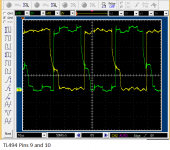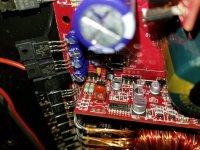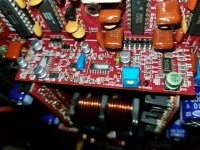I think the problem is the drive circuit is marginal go/no-go for this many 3205s.
Assuming that the 1k pulldown resistors are back to 1k ohms (on the main board), I'd try replacing the two 220 ohm pulldown resistors with 100 ohm resistors. They need to be rated for 1w if you use them long term but a 1/4 or 1/2w will tell you if they're going to make a difference.
Assuming that the 1k pulldown resistors are back to 1k ohms (on the main board), I'd try replacing the two 220 ohm pulldown resistors with 100 ohm resistors. They need to be rated for 1w if you use them long term but a 1/4 or 1/2w will tell you if they're going to make a difference.
You can try the other drivers. If they're faster, they 'may' help. Any other solutions I have would require mods that would not leave the circuit looking like it came from the manufacturer.
I removed the 3205s and now the square wave is good. So you are right the drive isn't pulling down hard enough to discharge the gate capacitance fast enough. The C1815 don't look to be any faster per spec sheet.
Last edited:
That was a lot of work to remove all of the 3205s.
Did you try reinstalling only one per bank and then check the idle current?
Did you try reinstalling only one per bank and then check the idle current?
However that is NOT the source of the current draw!
I put just 2 3205s back and there's no more overlap, but still high current pull! So now what? Maybe there's an issue with the rail caps? I think I'll pull the diodes and see what happens.
Diodes removed and current is staying at about 1.2 A. Much more reasonable. So issue is after the diodes...
I put just 2 3205s back and there's no more overlap, but still high current pull! So now what? Maybe there's an issue with the rail caps? I think I'll pull the diodes and see what happens.
Diodes removed and current is staying at about 1.2 A. Much more reasonable. So issue is after the diodes...
Last edited:
See Post 31. Also I removed the rail caps and tested them; they are good and current draw did not decrease with them removed.
If you find that it's the output stage causing the high current draw, replacing the IRF640s with IRFB31N20Ds (do NOT buy from ebay) may help.
Perry,
What about the IRF9640s?
Back to those resistors that I said were getting hot earlier. They are not 22k. They are 2.2k (red red red) and I tried replacing them with 22k and the amp started pulling 10+ amps and smoked the 2 PSU supply FETs.
Anyway, those resistors have nearly 120V across them. 120/2200=0.05 So they should only draw only 0.05A each. That's over 6 watts so it makes sense they get hot, but wouldn't be the cause of the current draw.
So next item: I noticed the current draw greatly increases as I increase the supply voltage. At 12V it's drawing 8Amps.
So would the output FETs cause that increased current draw from an increase of input voltage to the supply?
What about the IRF9640s?
Back to those resistors that I said were getting hot earlier. They are not 22k. They are 2.2k (red red red) and I tried replacing them with 22k and the amp started pulling 10+ amps and smoked the 2 PSU supply FETs.
Anyway, those resistors have nearly 120V across them. 120/2200=0.05 So they should only draw only 0.05A each. That's over 6 watts so it makes sense they get hot, but wouldn't be the cause of the current draw.
So next item: I noticed the current draw greatly increases as I increase the supply voltage. At 12V it's drawing 8Amps.
So would the output FETs cause that increased current draw from an increase of input voltage to the supply?
Last edited:
The resistor isn't passing the current that's causing the amp to draw excessive current but it may have an effect on the overall circuit function.
The 640s are the only ones I replace.
If the rail voltage is changing with the 12v supply input voltage, that could explain the difference in current draw.
Is the rail voltage regulated?
Are the rails of equal magnitude above and below ground?
The 640s are the only ones I replace.
If the rail voltage is changing with the 12v supply input voltage, that could explain the difference in current draw.
Is the rail voltage regulated?
Are the rails of equal magnitude above and below ground?
-52 versus 51.2 with 10.1V input.
-62 versus 61.6 with 12.2V input.
So not regulated, but equal amounts above and below ground.
I'll order the IRFB31N20Ds and we will see how it goes. Thank you!
-62 versus 61.6 with 12.2V input.
So not regulated, but equal amounts above and below ground.
I'll order the IRFB31N20Ds and we will see how it goes. Thank you!
The target rail voltage may be higher than 62v and may take more than 12.2v to reach it. If that's the case, you'll see rail voltage level out when you can increase the 12v supply voltage.
Replaced the 640s with new IRFB3N20Ds from Mouser and we are still pulling 3+ amps. Gotta be something else bad on this board pulling the extra current.
DC offset adjustment.
Why do you think 3 amps is too much?
Are the output transistors heating up?
What was causing the high current draw initially? What fixed that?
Why do you think 3 amps is too much?
Are the output transistors heating up?
What was causing the high current draw initially? What fixed that?
- Status
- Not open for further replies.
- Home
- General Interest
- Car Audio
- Orion 1200D Pulling 4+ amps at idle but does produce sound



